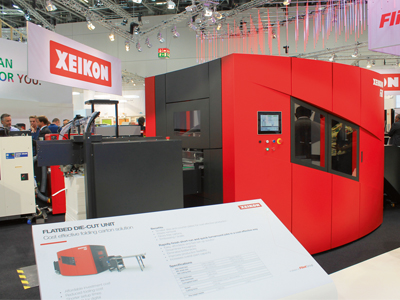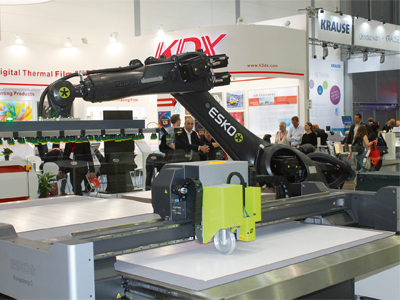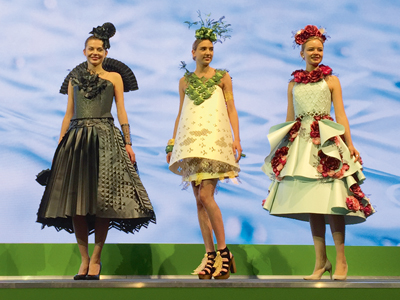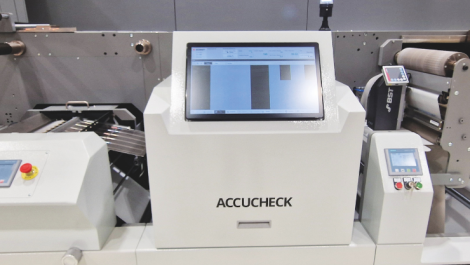Highcon wowed drupa visitors with a fashion show highlighting its cutting expertise
An often-overlooked process, getting the die-cutting right is vital. Beautiful digital print is nothing if the shape of the label or the carton is not perfect. Cutting the shapes of packaging can be done in a variety of ways depending on the substrate and the job size. By Neel Madsen.
For self-adhesive labels, traditional rotary or semi-rotary systems will cut the label shape using pressure to break the fibres of the substrate down to the release liner. Flexible dies mounted on a magnetic cylinder on semi-rotary systems are most common, although solid dies are also used, particularly for very long runs in conventional printing. These are mounted in a die-cutting station either on a finishing line or as part of the press platform itself.
For other applications, such as cartons or corrugated, an offline die-cutting machine can be set up for short to medium production runs, while a cutting table will do the job when we are talking about samples or very short runs.
Cutting tools
Flexible dies are quick to produce and easy to ship, and can cut a wide variety of label types. Made from steel sheets, they are precision manufactured using CNC engraving technology made to extremely tight tolerances, with or without special coatings for a smooth surface and easy release. The edges of the engraving are finely milled to ensure accurate cutting performance; the exact specifications depend on the application.
Having optimised its wide portfolio into a leaner range of flexible dies, RotoMetrics now offer the Accu-Series. This comes four varieties allowing converters to choose the most appropriate for their specific requirements. AccuSmart is the economical choice for most short and medium run lengths; AccuPrime is the choice for converting of a wider range of substrates; AccuStar Ultra-Film has been developed for challenging synthetics; and AccuStar Life is for converting more abrasive materials.
Spanish manufacturer of flexible dies, Lartec exports its products to over 100 countries worldwide. It offers various types of treatment to extend the life of the die. The Enduro plasma treatment employs a titanium hardening process to increase the hardness and wear resistance by reducing the friction coefficient. The Anti-Tack treatment applies a non-stick coating to the surface of the flexible die to repel dirt, adhesive or ink residue. This allows improved speed and quality of waste removal, and reduces time spent cleaning the plates.
Kocher+Beck’s AI Universal Flexible Dies are designed for all types of self-adhesive and single-material products, including paper, PP, PE, PVT, PET, Tyvek, thin films on PET liner material and other materials that are difficult to cut. This can be for both kiss-cutting and cutting down to the anvil. They are CNC-sharpened and feature smooth polished cutting edges obtained using an ultra-fine edge polishing technique. Profile heights range from 0.30 to 1.5 mm and cutting angles vary, depending on the material, from 30 to 110 degrees.
New at drupa
Die-cutting of sheetfed cartons or corrugated board is a whole different ball game. When these jobs are printed digitally, and thus of a much shorter job length than offset litho, the time and cost of setting up industrial-sized, conventional die-cutters is not cost-effective, but there are many other options.
Bograma offers a range of die-cutting machinery. At drupa, it showed two versions of the BSR 550 servo rotary die-cutter. The new BSR 550 basic features short set-up times, simple operation, economic and cost-efficient production. It is compact and designed for users who want to produce short and medium print runs economically and efficiently. The offline system is suitable for die-cutting, kiss-cutting, creasing, perforating and embossing a wide range of products, not just for packaging and labels, but also mailings and presentation. Die-cutting is done with two magnetic cylinders using the company’s established technology, while the breakout and deliver unit has been redesigned. So for example all air nozzles and deflecting pulleys can be inserted and aligned without using tools. To exchange the flexible dies the entire unit is disconnected from the die-cutting area.
Highcon was the first to present digital cutting and creasing with its Euclid machine launched in 2012. This employs a Digital Adhesive Rule Technology, or DART, which writes digital rules onto a foil, replacing traditional rules and channels, for the creasing process. Once the sheets are creased, they are cut, perforated or etched with CO2 lasers and optics.
drupa saw the latest iteration launched, the Highcon Beam (named after its high speed). Joining Glossop Cartons, which took delivery of the first beta machine in March, is All Packaging Company, which has plants in Denver, Colorado and Salt Lake City, Utah. The folding carton company is the first new customer in North America to purchase the Beam digital cutting and creasing machine, which will not only be its first Highcon machine, but also the first digital machine to enter its current conventional production workflow.
Ken Pepper, president and CEO, said, ‘I have been following Highcon technology since the beginning and have been impressed with their innovative spirit and vision. I’m really excited that the technology has now reached the point where it has become mainstream, and can be used on higher volume production. The Highcon Beam will have speeds of up to 5000 sheets per hour on B1/42 inch size, wider substrate range, and built-in scrap stripping capabilities. This will fit perfectly into our production workflows, and will open up new markets for our sales team.’
Kama showed the DC 76 ASB automatic die-cutter. This is a versatile post-press processing machine, which is capable of handling 760 x 600 mm sized sheets. The new Kama AutoRegister feature adjusts each sheet to a print mark to secure accurate finishing of digitally printed and cut sheets.

Xeikon’s FDU saw its debut at drupa
Also at the show, Xeikon added the new FDU (Flatbed Die-cut) unit to its Folding Carton Suite for inline production. Although it is built to suit the Xeikon press portfolio, it can also handle materials from conventional or other digital presses, at 2000 sheets/hr, up to 890 microns.
Esko’s versatile range of Kongsberg flatbed cutting tables are often used for very short runs and samples. Earlier this year, the company streamlined its portfolio so customers can now choose from two lines, Kongsberg X and Kongsberg C – each having a range of table sizes and configurations. The first offers the flexibility of upgrading to add more cutting, creasing and milling tools as the business needs develop, while Kongsberg C is aimed at short run production, building on the existing Kongsberg C line, which was extended with smaller table sizes.

Auto loading/unloading on the Kongsberg table
As well as the Auto Tool Adjust, which uses camera inspection and digital image processing to adjust the tool in the machine at the start of each job, the larger tables can now be fitted with a ‘robotic’ arm for automatic loading and unloading of sheets.






